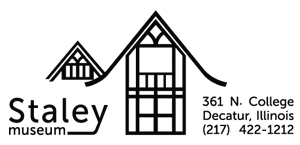Staley’s Bears 1920-1921
ANDREW DAVID “WINDY” & “DOC” LOTSHAW
Born: January 27, 1880 Cold Springs, Dearborn County, IN
Died: February 21, 1953 Indianapolis, IN
High School: None
College: None
Staleys: 1920 & 1921
In January 1953, famed Chicago Tribune sports writer Edgar Munzel described the retiring Andy Lotshaw as a “former player, trainer, fighting man, yarn spinner, wisecracker …” who “had the sharp wit of Groucho Marx” and “was a master of repartee even though he was ignorant of grammar, brutalized spelling and pronunciation.” A former minor league baseball power hitter, the thirty-nine year old Lotshaw was recruited to play for the 1919 Staley nine but delayed showing up in Decatur until the last two games in October. He remained in town, became a fulltime Staley employee, and in 1920 was a reserve on the company baseball team captained by George Halas. That September, when Wee Willie McGill quit his job in a pique as trainer for the Halas football team, Lotshaw hurriedly volunteered to take over the job for which he had little training, and kept it until 1951. As Munzel opined, “Andy would do anything for you and no task was too menial.”
Andy was born in southern Indiana in 1880 but moved to Indianapolis around age nine when his father Oscar left dairy farming for a factory job in the state’s capital city. After possibly finishing eighth grade, Andy worked in a furniture factory and by 1898 had married Emma Florence Otis and had daughter Gertrude May. [The couple divorced November 28, 1904.] He played semi-professional baseball for several teams in the Indianapolis area at the turn of the century and got his photo in the Indianapolis Star [the first of literally thousands of him in newspapers] for his athletic skills on April 27, 1904. In 1906, the now dubbed “Windy” made it to the official minor leagues and got paid $65.00 a month to play 127 games for Jacksonville, IL in the Class D “Kitty League” [Kentucky, Illinois and Tennessee teams].
In 1907 Lotshaw played 73 games for Class D Charleston, IL and in March 1908 was traded to the Marion “Diggers” in Ohio for infielders Porter Heckman and L. Uhl and outfielders Harry Hardy and George Hogan. However “Windy” ran into trouble due to his rough play and constant “chawing” at and “riding” of opposing players. The Marion paper, run by future U.S. President Warren G. Harding, also a co-owner of the Diggers, referred to Windy as “loquacious”. In mid-May, pitcher Walter Justus of the Lancaster “Lanks” could take no more sass during a series, attacked first baseman Lotshaw with a bat and broke his hand. Lotshaw recovered to play in June and July before Marion manager Charles O’Day told the overly aggressive Windy in mid-August that his services were no longer needed. Lotshaw finished that season with the Portsmouth, OH “Cobblers”.
From 1909 through 1914 Andy had over 2000 at bats with Illinois D League affiliates in Beardstown, Galesburg, Canton [in two seasons he had a .350 BA and hit 40 home runs] and Champaign. After staying away from professional sports for two years he was assisting the AA [then the highest level] minor league affiliate Indianapolis Indians in 1917 when during the playoffs he was called, not off the bench but out of the locker room, to participate. At age 37, sportswriters have repeatedly chronicled he got 17 hits in 24 at bats that October [official records say 8 hits in 19 at bats] to propel the Indians over the Toronto nine to win the “Little World Series”. He assisted and played in nine games with Indy in 1918 while reportedly also doing a short stint in the Army medical corps before finishing his baseball career in 1919 in Brantford, Ontario and then moving to Decatur. He had married Laura M. Whiteley in Louisville, KY on June 4, 1918 and it was time he settled down.
As Edgar Munzel related in 1953, after new Staley hire George Halas toured the starch facility in March 1920 he asked “Who was that windy guy down in the millwright department?” Plant superintendent George Chamberlin identified the loud chatterbox as Andy Lotshaw, one of the most popular men in the plant and the recent recipient from his fellow workers of the “Croix de Bull” silver medal. Halas and Lotshaw were soon playing together on the company baseball team. Standing next to Windy in the team photo that year was pitcher Harry Rush. Little did either of them know that 28 years later Windy would be giving his patented arm rub to Harry’s son, Chicago Cubs pitcher and two-time MLB all-star Robert Ransom Rush.
In September 1920 Lotshaw became the trainer for the company football team and did every other odd job he could such as help his wife repair and wash the teams’ uniforms. At the end of the season Halas authorized a bonus of $175 for Windy’s services. He repeated these tasks for the Staley team in 1921 as they played most of their games in Chicago and he later became the permanent Chicago Bears trainer from 1922 to 1951.
During the 1921 football season Lotshaw remained an A.E. Staley employee. As of March 1, 1922 he resigned his job and publicly thanked Mr. Staley for his “kindness.” Windy reported back to his old American Association baseball club in Indianapolis and spent that season as their trainer. Continuing to be in the right place at the right time, Lotshaw attended the annual Cubs/White Sox cross-town baseball series in Chicago and was in Cubs Park when future Hall of Fame Cubs’ pitcher Grover Cleveland Alexander developed a sore right shoulder. When Cubs president Bill Veeck, Sr. learned of Windy’s presence, he requested that Andy work on the star pitcher’s wing. Alexander came back to win the last game of the miniseries on October 15, 1922 giving the Cubs their first series win in 13 years. According to legend, Veeck gave Lotshaw a $300 present and hired him on November 7th to replace Chris Schurrer as Cubs trainer. Starting in February 1923, Windy went to Catalina Island ahead of the team each year to prepare for spring training camp until his baseball retirement in 1952.
While the Sporting News and other papers are full of anecdotes and photos [packing equipment, taping ankles, winning dance contests in the Avalon ballroom, quartet singing for Chicago baseball writers’ shows, speaking at dozens of hot stove league banquets] relating to Lotshaw’s 30-year tenure as Cubs trainer, there are very few stories about his time with the Bears. Several possible reasons for this are: the football team had a shorter season and only played 12-16 games a year; Halas did not tolerate nonsense in his club house; the rough around the edges trainer had less in common with the mostly college-educated football players than with the usually much less formally-educated, tobacco spitting baseball men who were more his peers.
Two of the oft told Lotshaw stories took place at Wrigley Field in the early 1930s and relate to Windy’s windiness. During practice one day, Lotshaw was in the dugout replying to abuse from ace Cubs pitcher Pat Malone. Malone said if Windy was such a hot shot minor league power hitter why not come out and show it. Malone was sure he could strike him out on three pitches. Lotshaw, in street clothes and shoes, grabbed a bat and strode to the plate. The fifty-some year old Andy drove Malone’s first pitch over the right field wall and that was that. In the third game of the 1932 World Series the New York Yankees visited Chicago on October first. One version of the story as told by Richards Vidmer of the New York Herald Tribune explained that the Cubs bench had been heckling Babe Ruth all day and that Lotshaw yelled, “If I had you, I’d hitch you to a wagon, you potbelly.” Having already hit a home run in the first inning, Ruth came to the plate in the 5th inning and as legend has it took two strikes from Charley Root then “called the shot” and hit a homer on the next pitch. In this, one of many versions, Ruth later reported “I didn’t mind no ballplayers yelling at me, but the trainer cutting in – that made me sore.”
By the late 1930s Lotshaw was one of the best known and highest paid of any professional sports trainers. He had also created Andy Lotshaw Body Rub, advertised nationally as “The rub used by Andy Lotshaw, Trainer of Champions, for ‘magic-like’ relief from tired, stiff, aching muscles due to work or exercise.” The ingredients were a mystery but at a 1939 Decatur sports banquet Andy claimed that chief Staley chemist Howard File and helped create a rubbing liniment that he used in 1920. Dizzy Dean claimed that Windy had rejuvenated his arm in 1938 with massage and ointment as the Cubs won the pennant. By 1950, Lotshaw had also created “Pellent” – a mosquito ointment to repel insects from hunters and other sportsmen. Both products were still sold for several years after his death.
Andy Lotshaw was the sole Bears trainer as they won NFL national championships in 1922, 1932, 1940, 1941 and 1946. However, in 1947 George Halas brought in fellow WW II naval officer Ed [nee Rozmarynoski] Rozy to share training duties with the club. 1951 was Windy’s last season with the Bears and in March 1952, he received his first $100 monthly pension check from Major League Baseball while preparing for his last season with the Cubs. Barely five months after fully retiring and moving back to Indianapolis he suffered a heart attack and died. His wife Laura and foster son Homer Petero survived him. He was buried in Oak Hill Cemetery, Lebanon, IN.
Like his Decatur boss A. E. Staley, Lotshaw was a devoted Mason, reaching 32nd degree status, a member of the Shrine, Scottish Rite, Knights Templar and Order of Eastern Star. His favorite Bears player was Bronco Nagurski and favorite Cub was Phil Cavarretta because both were so tough and dedicated to winning. Andy Lotshaw viewed himself as both a medical man and cheerleader. He said,
“A man can’t be a good trainer if he’s thinking only of muscles and bones. It’s just as much a part of his job to pep up the players and make them want to play.”
Copyright @ Mark W. Sorensen
September 16, 2019

